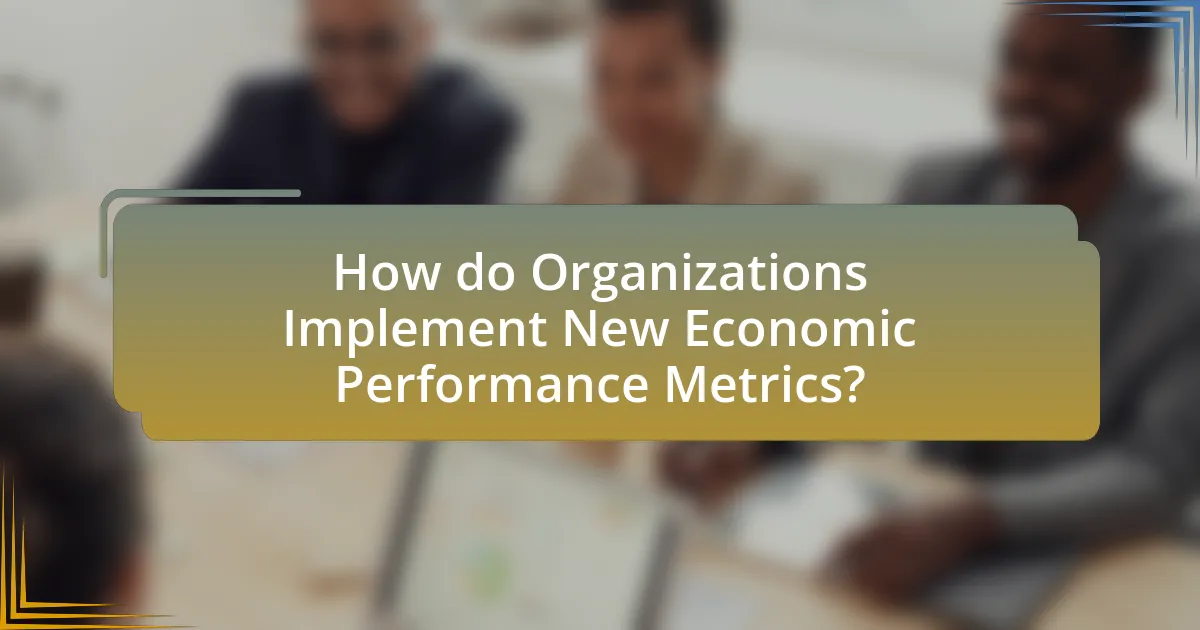The article focuses on the evolution of economic performance metrics in the digital age, highlighting the transition from traditional indicators to more comprehensive measures that incorporate digital data and technology. It discusses the limitations of conventional metrics, the influence of technological advancements, and the necessity for businesses to adapt their performance measurement systems to remain competitive. Key performance indicators (KPIs) relevant to the digital economy, such as customer lifetime value and engagement rates, are examined, along with the role of data analytics in reshaping these metrics. The article also outlines best practices for organizations to implement new metrics effectively and explores future trends, including the impact of artificial intelligence and emerging technologies on economic performance measurement.

What are Economic Performance Metrics in the Digital Age?
Economic performance metrics in the digital age are quantitative measures used to assess the economic health and productivity of organizations and economies, leveraging digital data and technology. These metrics include key performance indicators (KPIs) such as digital revenue growth, customer acquisition cost, return on investment (ROI) from digital initiatives, and user engagement metrics. For instance, a report by McKinsey highlights that companies utilizing advanced analytics can increase their profitability by 5-6% annually, demonstrating the impact of digital metrics on economic performance. Additionally, metrics like e-commerce sales growth and digital market share provide insights into how businesses adapt to digital transformation, reflecting their economic viability in a rapidly changing landscape.
How have traditional economic performance metrics evolved?
Traditional economic performance metrics have evolved from basic indicators like Gross Domestic Product (GDP) and unemployment rates to more comprehensive measures that incorporate factors such as sustainability, inequality, and digital economy contributions. Initially, GDP served as the primary measure of economic health, focusing solely on output without considering social and environmental impacts. Over time, metrics like the Human Development Index (HDI) and Genuine Progress Indicator (GPI) emerged, reflecting a broader understanding of well-being and economic quality. Additionally, the rise of digital technologies has led to the inclusion of metrics that assess digital economy performance, such as e-commerce growth and digital literacy rates, highlighting the importance of technology in modern economic assessments. This evolution signifies a shift towards a more holistic view of economic performance that accounts for diverse societal factors and the implications of digital transformation.
What were the key limitations of traditional metrics?
Traditional metrics primarily lacked the ability to capture the complexity and dynamism of modern economic environments. These metrics often relied on static data points, such as historical financial performance, which failed to account for real-time changes and the influence of digital transformation. For instance, traditional metrics like return on investment (ROI) did not consider intangible assets such as brand value or customer engagement, which are increasingly critical in the digital age. Additionally, traditional metrics often focused on short-term outcomes, neglecting long-term sustainability and growth factors, which are essential for evaluating performance in a rapidly evolving market landscape.
How did technological advancements influence these limitations?
Technological advancements significantly influenced the limitations of economic performance metrics by enhancing data collection, analysis, and reporting capabilities. For instance, the rise of big data analytics and machine learning has allowed for more accurate and real-time assessments of economic indicators, reducing the lag associated with traditional metrics. This shift has been evidenced by the adoption of advanced statistical methods and software, which enable economists to process vast datasets that were previously unmanageable, thus improving the precision of economic forecasts. Additionally, the integration of digital platforms has facilitated broader access to economic data, allowing for more inclusive and comprehensive evaluations of economic performance across different sectors.
Why is it important to adapt economic performance metrics in the digital era?
Adapting economic performance metrics in the digital era is crucial because traditional metrics often fail to capture the complexities and dynamics of digital economies. Digital platforms, for instance, generate vast amounts of data that influence consumer behavior and market trends, necessitating metrics that reflect real-time performance and user engagement. According to a report by McKinsey, companies that leverage advanced analytics can improve their profitability by 5 to 6 percent, highlighting the need for metrics that align with digital transformation. Furthermore, the rise of intangible assets, such as brand value and customer loyalty, requires new frameworks for measurement that go beyond conventional financial indicators.
What challenges do businesses face without updated metrics?
Businesses face significant challenges without updated metrics, including poor decision-making, inability to identify trends, and decreased competitiveness. Without current data, organizations struggle to make informed choices, leading to misallocation of resources and missed opportunities. Additionally, outdated metrics hinder the ability to recognize market shifts and customer preferences, which are crucial for adapting strategies. Research indicates that companies leveraging real-time data can improve operational efficiency by up to 30%, highlighting the importance of updated metrics in maintaining a competitive edge.
How do digital transformations impact economic performance measurement?
Digital transformations significantly enhance economic performance measurement by enabling real-time data analysis and improved accuracy in metrics. These transformations facilitate the integration of advanced technologies such as big data analytics, artificial intelligence, and cloud computing, which allow organizations to gather and process vast amounts of economic data efficiently. For instance, a study by McKinsey & Company found that companies leveraging digital tools can improve their decision-making speed by up to 5 times, leading to more timely and relevant economic performance assessments. Additionally, digital transformations allow for the development of new performance indicators that reflect the complexities of the digital economy, such as customer engagement metrics and digital revenue streams, thereby providing a more comprehensive view of economic performance.

What are the New Metrics Emerging in the Digital Age?
New metrics emerging in the digital age include Customer Lifetime Value (CLV), Net Promoter Score (NPS), and Engagement Rate. These metrics are designed to provide deeper insights into consumer behavior and business performance in a digital context. For instance, CLV quantifies the total revenue a business can expect from a customer throughout their relationship, allowing companies to tailor marketing strategies effectively. NPS measures customer loyalty by asking how likely customers are to recommend a business, providing a clear indicator of brand health. Engagement Rate assesses how actively users interact with content, reflecting the effectiveness of digital marketing efforts. These metrics are increasingly vital as businesses adapt to data-driven decision-making in a rapidly evolving digital landscape.
How do data analytics reshape economic performance metrics?
Data analytics significantly reshape economic performance metrics by enabling more precise measurement and forecasting of economic activities. Through the application of advanced statistical techniques and machine learning algorithms, organizations can analyze vast datasets to identify trends, correlations, and anomalies that traditional metrics may overlook. For instance, the use of real-time data analytics allows businesses to adjust their strategies based on immediate market conditions, leading to improved decision-making and resource allocation. A study by McKinsey & Company found that companies leveraging data analytics can increase their productivity by 5-6% annually, demonstrating the tangible impact of data-driven insights on economic performance metrics.
What types of data analytics are most relevant for performance measurement?
Descriptive analytics, diagnostic analytics, predictive analytics, and prescriptive analytics are the types of data analytics most relevant for performance measurement. Descriptive analytics provides insights into historical performance through data aggregation and visualization, allowing organizations to understand past trends. Diagnostic analytics goes further by identifying the reasons behind performance outcomes, often using techniques like root cause analysis. Predictive analytics utilizes statistical models and machine learning to forecast future performance based on historical data, enabling proactive decision-making. Finally, prescriptive analytics recommends actions to optimize performance, often using simulations and optimization algorithms. These analytics types collectively enhance the ability to measure and improve performance in various sectors, as evidenced by their widespread adoption in industries such as finance, healthcare, and marketing.
How can businesses leverage big data for better insights?
Businesses can leverage big data for better insights by utilizing advanced analytics to identify patterns and trends within large datasets. This approach enables companies to make data-driven decisions, optimize operations, and enhance customer experiences. For instance, a study by McKinsey & Company found that organizations that effectively use big data can increase their productivity by 5-6%. By analyzing customer behavior and preferences through big data, businesses can tailor their marketing strategies, leading to improved customer engagement and higher conversion rates.
What role do key performance indicators (KPIs) play in the digital economy?
Key performance indicators (KPIs) serve as essential metrics that enable organizations in the digital economy to measure performance, track progress, and make data-driven decisions. In the context of the digital economy, KPIs provide quantifiable measures that reflect the effectiveness of various business strategies, such as customer engagement, conversion rates, and operational efficiency. For instance, a study by McKinsey & Company highlights that companies utilizing KPIs effectively can improve their performance by up to 20%. This demonstrates that KPIs not only facilitate accountability but also drive strategic alignment and operational improvements in a rapidly evolving digital landscape.
Which KPIs are most effective in measuring digital economic performance?
The most effective KPIs for measuring digital economic performance include digital revenue growth, customer acquisition cost, conversion rates, and user engagement metrics. Digital revenue growth quantifies the increase in income generated from online channels, reflecting the overall success of digital strategies. Customer acquisition cost measures the expense incurred to gain a new customer, providing insight into marketing efficiency. Conversion rates indicate the percentage of users who take a desired action, such as making a purchase, which directly correlates with business effectiveness. User engagement metrics, such as time spent on site and interaction rates, assess how well digital content resonates with audiences. These KPIs are validated by industry reports, such as the “Digital Marketing Trends” report by HubSpot, which emphasizes their importance in evaluating digital performance.
How can businesses select the right KPIs for their needs?
Businesses can select the right KPIs by aligning them with their strategic objectives and ensuring they are measurable, relevant, and actionable. This alignment ensures that the KPIs reflect the specific goals of the business, such as increasing revenue, improving customer satisfaction, or enhancing operational efficiency. For instance, a study by the Harvard Business Review found that organizations that align KPIs with strategic goals are 30% more likely to achieve their objectives. Additionally, businesses should involve stakeholders in the KPI selection process to ensure buy-in and relevance across departments. This collaborative approach enhances the effectiveness of the chosen KPIs in driving performance and accountability.

How do Organizations Implement New Economic Performance Metrics?
Organizations implement new economic performance metrics by first identifying key performance indicators (KPIs) that align with their strategic objectives. This process often involves analyzing existing data and determining which metrics can provide insights into financial health and operational efficiency. For instance, a study by the Harvard Business Review highlights that companies like Amazon utilize metrics such as customer acquisition cost and lifetime value to drive decision-making.
Next, organizations typically integrate these metrics into their financial reporting systems, ensuring that data collection methods are robust and automated to minimize errors. This integration allows for real-time tracking and analysis, which is crucial in the fast-paced digital environment. According to a report from McKinsey, organizations that adopt advanced analytics to monitor these metrics can improve their financial performance by up to 20%.
Finally, organizations foster a culture of continuous improvement by regularly reviewing and adjusting these metrics based on market changes and internal performance. This iterative approach ensures that the metrics remain relevant and effective in guiding strategic decisions.
What steps should organizations take to transition to new metrics?
Organizations should follow a structured approach to transition to new metrics by first assessing their current performance measurement systems. This involves identifying existing metrics that no longer align with strategic goals and determining the new metrics that better reflect current business objectives. Next, organizations should engage stakeholders across departments to ensure buy-in and gather insights on relevant metrics.
After establishing the new metrics, organizations must implement training programs to educate employees on the importance and usage of these metrics. Additionally, organizations should integrate new metrics into existing reporting systems to facilitate seamless data collection and analysis. Finally, organizations need to continuously monitor and refine these metrics based on feedback and changing business environments to ensure they remain relevant and effective.
This systematic approach is supported by research indicating that organizations that actively involve stakeholders and provide training during metric transitions experience higher adoption rates and improved performance outcomes.
How can organizations assess their current performance measurement systems?
Organizations can assess their current performance measurement systems by conducting a comprehensive review that includes evaluating key performance indicators (KPIs), stakeholder feedback, and alignment with strategic objectives. This assessment involves analyzing the relevance and effectiveness of existing metrics in measuring organizational goals, ensuring they provide actionable insights. Research indicates that organizations that regularly review their performance metrics can improve decision-making and operational efficiency, as evidenced by a study from the Harvard Business Review, which found that companies with aligned performance metrics saw a 20% increase in productivity.
What training is necessary for staff to adapt to new metrics?
Staff must undergo training in data analysis, metric interpretation, and software tools to effectively adapt to new metrics. This training should include workshops on understanding key performance indicators (KPIs), utilizing analytics software, and interpreting data trends. Research indicates that organizations that invest in comprehensive training programs see a 20% increase in employee performance related to metric utilization. Additionally, hands-on practice with real data sets enhances staff confidence and competence in applying new metrics effectively.
What best practices should organizations follow when adopting new metrics?
Organizations should ensure alignment with strategic goals when adopting new metrics. This alignment guarantees that the metrics chosen directly support the organization’s objectives, enhancing decision-making and performance tracking. Additionally, organizations should involve stakeholders in the metric selection process to foster buy-in and ensure that the metrics are relevant and actionable. Research indicates that organizations that engage stakeholders in metric development see a 30% increase in metric utilization effectiveness. Furthermore, organizations should prioritize simplicity and clarity in metrics to facilitate understanding and communication across teams. Metrics that are easily interpretable lead to better insights and quicker responses to performance issues. Lastly, organizations should regularly review and refine metrics to adapt to changing business environments, ensuring ongoing relevance and effectiveness.
How can organizations ensure alignment between metrics and business goals?
Organizations can ensure alignment between metrics and business goals by establishing clear objectives and regularly reviewing performance indicators. This process involves defining specific, measurable, achievable, relevant, and time-bound (SMART) goals that directly relate to the organization’s strategic vision. Regularly analyzing key performance indicators (KPIs) against these goals allows organizations to adjust their strategies and metrics as needed. Research from the Harvard Business Review indicates that companies with aligned metrics and goals experience 30% higher performance than those without alignment, demonstrating the importance of this practice in driving economic success in the digital age.
What common pitfalls should organizations avoid during implementation?
Organizations should avoid inadequate planning during implementation. Insufficient planning can lead to misaligned objectives, resource misallocation, and failure to meet deadlines. For instance, a study by the Project Management Institute found that 39% of projects fail due to a lack of clearly defined goals and objectives. Additionally, organizations should steer clear of neglecting stakeholder engagement, as this can result in resistance to change and lack of support. Research indicates that projects with active stakeholder involvement are 20% more likely to succeed. Lastly, organizations must not overlook the importance of training and support for employees, as a lack of proper training can hinder adoption and utilization of new systems, leading to decreased productivity.
What are the Future Trends in Economic Performance Metrics?
Future trends in economic performance metrics include the integration of big data analytics, real-time data processing, and sustainability indicators. Big data analytics allows for more granular insights into economic activities, enabling businesses and governments to make informed decisions based on comprehensive datasets. Real-time data processing enhances the ability to monitor economic performance continuously, rather than relying on periodic reports, which can be outdated. Additionally, sustainability indicators are becoming increasingly important as stakeholders demand accountability regarding environmental and social impacts, reflecting a shift towards measuring not just financial performance but also long-term viability and ethical considerations. These trends are supported by the growing emphasis on data-driven decision-making and corporate social responsibility in the global economy.
How will artificial intelligence influence economic performance measurement?
Artificial intelligence will significantly enhance economic performance measurement by enabling more accurate data analysis and predictive modeling. AI algorithms can process vast amounts of economic data in real-time, identifying trends and patterns that traditional methods may overlook. For instance, a study by McKinsey Global Institute found that companies using AI for data analytics can improve their productivity by up to 40%. This capability allows for more nuanced performance metrics that reflect real-time economic conditions, leading to better decision-making and resource allocation.
What emerging technologies are likely to shape future metrics?
Emerging technologies likely to shape future metrics include artificial intelligence, blockchain, and the Internet of Things (IoT). Artificial intelligence enhances data analysis capabilities, enabling more accurate and real-time performance metrics through machine learning algorithms that can identify patterns and trends in large datasets. Blockchain technology provides transparency and security in data transactions, which can improve the reliability of metrics by ensuring data integrity. The Internet of Things connects various devices, generating vast amounts of data that can be leveraged to create more granular and context-aware metrics. These technologies collectively drive a shift towards more dynamic, real-time, and reliable economic performance metrics in the digital age.
What practical tips can organizations use to enhance their economic performance metrics?
Organizations can enhance their economic performance metrics by implementing data-driven decision-making processes. By leveraging advanced analytics and business intelligence tools, organizations can gain insights into operational efficiencies, customer behaviors, and market trends. For instance, a study by McKinsey found that companies using data analytics to drive decision-making can improve their productivity by 5-6%. Additionally, organizations should focus on aligning their performance metrics with strategic goals, ensuring that all departments are working towards common objectives. This alignment can lead to improved accountability and resource allocation, ultimately enhancing overall economic performance.
How can organizations continuously improve their performance measurement processes?
Organizations can continuously improve their performance measurement processes by implementing a cycle of regular review and adaptation of metrics based on real-time data and stakeholder feedback. This approach allows organizations to identify inefficiencies and areas for enhancement, ensuring that performance metrics remain relevant and aligned with strategic goals. For instance, a study by the Harvard Business Review found that companies that regularly update their performance metrics based on data analytics see a 30% increase in operational efficiency. By leveraging technology and data analytics, organizations can refine their measurement processes, making them more agile and responsive to changing market conditions.
What resources are available for organizations seeking to refine their metrics?
Organizations seeking to refine their metrics can utilize various resources, including data analytics tools, benchmarking reports, and industry-specific guidelines. Data analytics tools, such as Tableau and Google Analytics, provide insights into performance metrics by visualizing data trends and patterns. Benchmarking reports from organizations like the International Organization for Standardization (ISO) offer comparative data that helps organizations assess their performance against industry standards. Additionally, industry-specific guidelines, such as those from the Financial Accounting Standards Board (FASB), provide frameworks for measuring and reporting economic performance accurately. These resources collectively enable organizations to enhance their metric refinement processes effectively.


